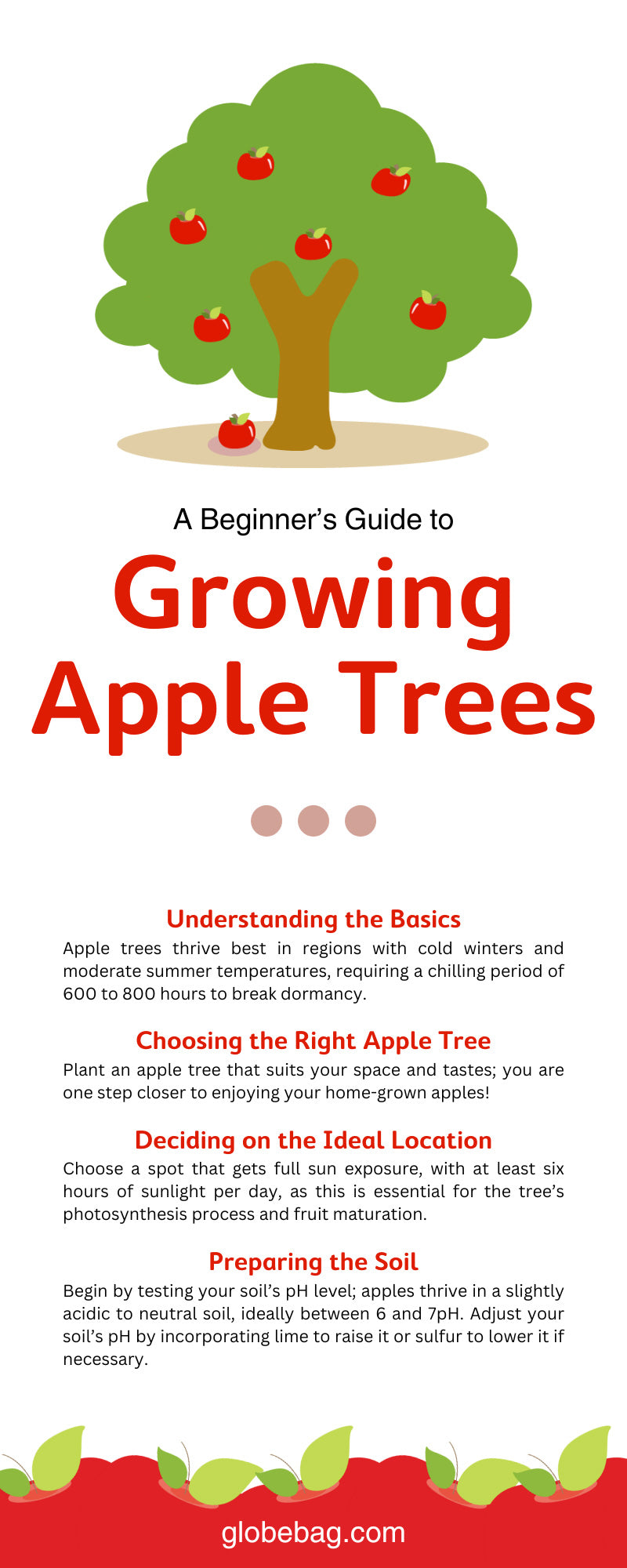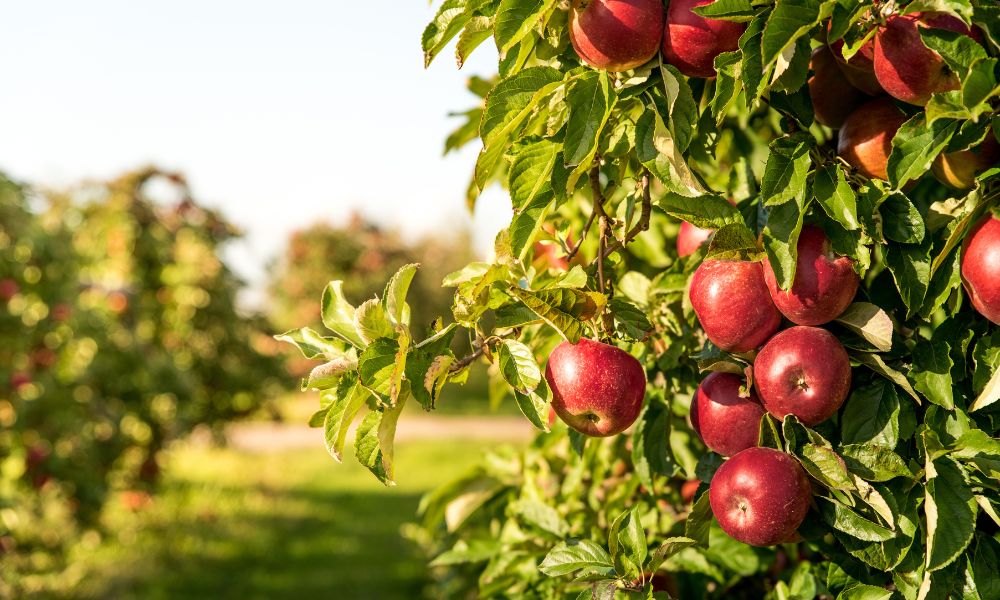Growing apple trees is a great learning experience for novice and expert gardeners. These versatile trees enhance your garden’s visual appeal with their blossoms and fruit and provide a delicious, nutritious harvest. Use this beginner’s guide to growing apple trees and equip yourself with the knowledge of a gardening expert.
Understanding the Basics
Before you dig into the soil and plant your first apple tree, you must understand a few key factors. Apple trees thrive best in regions with cold winters and moderate summer temperatures, requiring a chilling period of 600 to 800 hours to break dormancy.
Select a sunny, sheltered spot for your tree, as apple trees need at least six hours of sunlight daily to produce a bountiful crop. Different apple varieties have different growth and care requirements. For example, a Gala apple tree needs 500 chill hours, while an Empire apple tree needs full sun.
Choose a type that suits your climate, soil conditions, and taste preferences. Understanding these basic principles sets a strong foundation for your apple-growing journey.
Choosing the Right Apple Tree
Picking the right apple tree for your garden is a critical decision that will significantly influence your tree’s growth and fruit production. Consider factors such as the tree’s size at maturity and the apple’s flavor and uses. Dwarf apple trees are popular for small spaces, while standard apple trees are ideal for larger gardens and generate more fruit.
Consider common apple varieties like the sweet Honeycrisp, the classic Golden Delicious, or the versatile Granny Smith, all known for their unique flavors and uses. Plant an apple tree that suits your space and tastes; you are one step closer to enjoying your home-grown apples!
Deciding on the Ideal Location
Location is an important aspect of the growing process that determines the tree’s safety and growth rate. Choose a spot that gets full sun exposure, with at least six hours of sunlight per day, as this is essential for the tree’s photosynthesis process and fruit maturation. The site needs good air circulation to prevent diseases and well-drained soil to prevent waterlogging.
Avoid low-lying areas prone to frost and strong winds that can damage the tree’s blossoms. A north or northeast-facing slope is typically ideal as it ensures gradual warming in spring, which helps the tree avoid frost damage.
Preparing the Soil
The soil needs optimal conditions for the apple tree for optimal growth. Begin by testing your soil’s pH level; apples thrive in a slightly acidic to neutral soil, ideally between 6 and 7pH. Adjust your soil’s pH by incorporating lime to raise it or sulfur to lower it if necessary.
Enrich your soil with organic matter such as compost or well-rotted manure to improve soil structure and provide essential nutrients. Also, ensure your soil drains well, as apple trees don’t tolerate waterlogged conditions. Consider building a raised bed or planting the tree on a slope if drainage is a problem.
Planting Your Apple Tree
Planting your apple tree is a pivotal step in your apple-growing journey. Follow these steps for a successful planting:
- Start by digging twice the width and depth of the tree’s root ball.
- Place the tree in the hole, ensuring that the bud union, the bulging area where the fruiting variety grafts onto the rootstock, is above the soil level.
- Fill the hole halfway with soil, with most of it covering the roots, and water it to eliminate air pockets.
- Fill the rest of the hole with soil, forming a slight mound around the tree’s base to encourage water runoff.
- Stake the young tree to provide support, protect it from strong winds, and guide its upright growth.
Follow these steps to avoid future issues that may result in poor growth. Nurture it with care and patience; your apple tree will reward you with years of fruitful harvests.
Watering and Fertilizing Your Apple Tree
Regular watering and fertilizing are crucial to your apple tree’s growth and productivity. Young trees require consistent moisture, particularly in dry periods. Once established, apple trees are relatively drought-resistant, but a deep watering every two weeks during dry spells supports healthier growth.
Placing mulch around the base of the tree retains the soil’s moisture and suppresses weeds. Fertilize your apple tree in the early spring using a balanced, slow-release fertilizer to provide essential nutrients for growth and fruit production.
Pruning and Training Young Apple Trees
During the first few years, pruning focuses on creating a strong, balanced structure, while later, the emphasis shifts to maintaining the tree’s shape and promoting fruit production. Typically, pruning occurs in late winter or early spring when the tree is dormant.
Remove any dead, damaged, or disease-prone branches. Thin-out branches allow sunlight and air to reach all parts of the tree, which is crucial for the growth of high-quality fruit.
Training involves directing the growth of your tree using ties and weights to achieve the desired shape and size. You could train trees by growing them against walls or bending branches at different angles during the early growth stage for various shapes. This practice encourages the growth of fruiting branches and helps manage the tree’s size, making harvest easier.
Pest and Disease Management
A crucial aspect of ensuring the well-being of your apple trees is the effective management of pests and diseases. Regularly examining your trees helps detect early signs of infestation or disease, enabling timely intervention. Use organic pest control methods like introducing beneficial insects or using horticultural oils to keep pests at bay. Opt for organic fungicides and practice good sanitation by removing fallen or diseased fruits to reduce disease risks.
Harvesting Apples
Harvesting apples at the right time for the best flavor and texture is crucial. Generally, apples are ready to harvest when they’ve reached their full color, which varies by variety, and when they come off the branch easily.
A simple test is to cup an apple in your hand, lift it upward, and twist; if it releases from the tree, it’s ready. Furthermore, the apple’s flavor and texture upon tasting are good indicators of its readiness.
Storing and Using Your Apples
Proper storage and utilization of your harvested apples extend their freshness and allow you to enjoy their delicious flavor for longer. Store your freshly picked apples in a cool, humid environment, such as a refrigerator drawer, with each fruit wrapped individually in newspaper to prevent the spread of any potential spoilage. Use packaging for apples, such as apple boxes and bags, for an organized way to bundle and transport them.
Sort through your harvested apples, using any with blemishes or bruises immediately, as these will not store well. You can use your home-grown apples in countless ways, from eating them fresh to incorporating them into various dishes, like pies, sauces, and salads.
With patience, care, and a firm grasp of the basics, growing apple trees is a rewarding and fruitful endeavor accessible to gardeners of all skill levels. Even though challenges may arise along the way, the sweet taste of success, in the form of a crunchy apple, makes the journey worthwhile. Use this beginner’s guide to grow your first apple tree and embark on an adventure filled with learning and personal growth.

